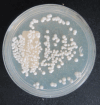Evaluation of epidemiological, clinical, and microbiological features of vulvovaginal candidiasis
- PMID: 40417277
- PMCID: PMC12101135
- DOI: 10.3205/dgkh000544
Evaluation of epidemiological, clinical, and microbiological features of vulvovaginal candidiasis
Abstract
Background: Vaginal candidiasis is induced by abnormal growth of yeast on the mucous membranes of the female genital tract. Approximately 75% of women experience a yeast infection once in their lifetime. This study explored the epidemiological, clinical, and microbiological features of vaginal candidiasis in diabetic women referred to health and treatment centers in Kermanshah in 2023.
Methods: This cross-sectional descriptive study was conducted on 215 diabetic women. A questionnaire was prepared for each participant. The samples were examined microscopically and cultured on Sabouraud dextrose agar (SDA). To identify different species of Candida (C.), various complementary tests were performed, such as the germ tube and differential sugar absorption test (API). A sensitivity test was applied to positive samples by the broth macrodilution method. Data were analyzed using the chi-squared test in SPSS.
Results: Out of the 215 vaginal swabs investigated, 66 specimens were Candida-species positive (30.7%). 11.6% of participants were diagnosed with candidal vulvovaginitis by direct microscopic examination and 20.9% by culturing on SDA. The Candida species isolated were: C. albi ca n s with 36 cases (54.5%), C. glabrata with 14 cases (21.2%), C. tropicalis with 9 cases (13.6%) and C. parapsilosis with 7 cases (10.6%). All species isolated showed the same sensitivity to the antifungal drugs used.
Conclusion: The culture method was more sensitive than the direct microscopic examination. C. albicans was the most prevalent species isolated from patients. Non-albicans species were not prevalent.
Hintergrund: Die vaginale Candidiasis wird durch das abnormale Wachstum von Hefepilzen auf der Schleimhaut des weiblichen Genitaltrakts hervorgerufen. Ungefähr 75% der Frauen erleiden einmal im Leben eine Hefepilzinfektion. Diese Studie untersuchte die epidemiologischen, klinischen und mikrobiologischen Merkmale der vaginalen Candidiasis bei diabetischen Frauen, die im Jahr 2023 an das Gesundheits- und Behandlungszentren in Kermanshah überwiesen wurden.
Methode: Die deskriptive Querschnittsstudie wurde an 215 Diabetikerinnen durchgeführt. Für jede Teilnehmerin wurde ein Fragebogen erstellt. Die Proben wurden der mikroskopischen Untersuchung und Kultur auf Sabouraud-Dextrose-Agar (SDA) unterzogen. Ergänzende Tests wurden durchgeführt, um verschiedene Candida-Arten zu identifizieren, wie z.B. Keimschlauchtest und Zuckerabsorptionstests (API). Der Sensitivitätstest wurde auf die positiven Proben mittels der Bouillon-Makrodilutionsmethode angewendet. Die Daten wurden mit SPSS unter Verwendung des Chi-Quadrat-Tests analysiert.
Ergebnisse: Von 215 untersuchten Vaginalabstrichen waren 66 Proben positiv auf Candida-Spezies (30,7%). Bei 11,6% wurde durch direkte mikroskopische Untersuchung, bei 20,9% durch Kultivierung auf SDA eine Candida-Vulvovaginitis diagnostiziert. Die isolierten Candida-Arten waren: Candida (C.) albicans mit 36 Fällen (54,5%), C. glabrata mit 14 Fällen (21,2%), C. tropicalis mit 9 Fällen (13,6%) und C. parapsilosis mit 7 Fällen (10,6%). Die Empfindlichkeit der isolierten Arten gegenüber den verwendeten Antimykotika war gleich.
Schlussfolgerung: Die Kulturmethode war empfindlicher als die direkte mikroskopische Untersuchung. C. albicans war die am häufigsten isolierte Spezies. Allerdings kamen keine non-C. albicans Arten vor.
Keywords: diabetes mellitus; vaginal candidiasis; women.
Copyright © 2025 Faraji et al.
Conflict of interest statement
The authors declare that they have no competing interests.
Figures





Similar articles
-
Evaluation of risk factors in patients with vulvovaginal candidiasis and the value of chromID Candida agar versus CHROMagar Candida for recovery and presumptive identification of vaginal yeast species.Med Mycol. 2011 Jan;49(1):16-25. doi: 10.3109/13693786.2010.497972. Epub 2010 Jul 7. Med Mycol. 2011. PMID: 20608776
-
Prevalence, species distribution and antifungal susceptibility of Candida albicans causing vaginal discharge among symptomatic non-pregnant women of reproductive age at a tertiary care hospital, Vietnam.BMC Infect Dis. 2021 Jun 3;21(1):523. doi: 10.1186/s12879-021-06192-7. BMC Infect Dis. 2021. PMID: 34082699 Free PMC article.
-
Vulvovaginal candidiasis, an increasing burden to women in the tropical regions attending Bharatpur Hospital, Chitwan.J Mycol Med. 2024 Dec;34(4):101509. doi: 10.1016/j.mycmed.2024.101509. Epub 2024 Sep 3. J Mycol Med. 2024. PMID: 39276531
-
Molecular epidemiology, antifungal susceptibility, and ERG11 gene mutation of Candida species isolated from vulvovaginal candidiasis: Comparison between recurrent and non-recurrent infections.Microb Pathog. 2022 Sep;170:105696. doi: 10.1016/j.micpath.2022.105696. Epub 2022 Jul 31. Microb Pathog. 2022. PMID: 35921954 Review.
-
An Update on the Roles of Non-albicans Candida Species in Vulvovaginitis.J Fungi (Basel). 2018 Oct 31;4(4):121. doi: 10.3390/jof4040121. J Fungi (Basel). 2018. PMID: 30384449 Free PMC article. Review.
References
-
- Brownrigg JR, Hughes CO, Burleigh D, Karthikesalingam A, Patterson BO, Holt PJ, Thompson MM, de Lusignan S, Ray KK, Hinchliffe RJ. Microvascular disease and risk of cardiovascular events among individuals with type 2 diabetes: a population-level cohort study. Lancet Diabetes Endocrinol. 2016 Jul;4(7):588–597. doi: 10.1016/S2213-8587(16)30057-2. - DOI - PubMed
-
- Gunther LS, Martins HP, Gimenes F, Abreu AL, Consolaro ME, Svidzinski TI. Prevalence of Candida albicans and non-albicans isolates from vaginal secretions: comparative evaluation of colonization, vaginal candidiasis and recurrent vaginal candidiasis in diabetic and non-diabetic women. Sao Paulo Med J. 2014;132(2):116–120. doi: 10.1590/1516-3180.2014.1322640. - DOI - PMC - PubMed
LinkOut - more resources
Full Text Sources
Miscellaneous

